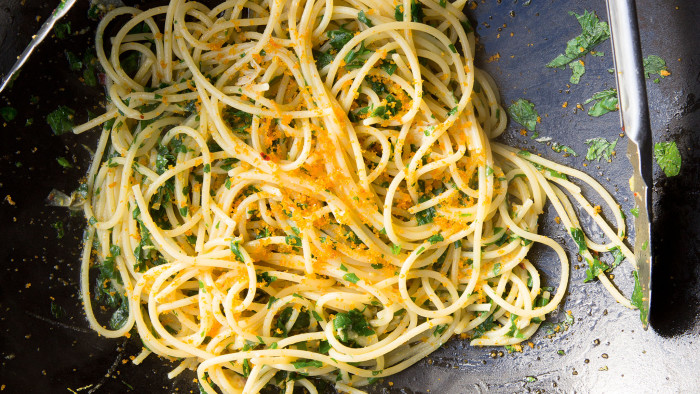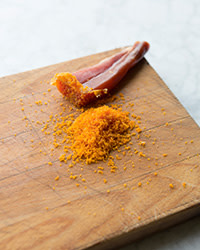Recipe: spaghetti with bottarga


Roula Khalaf, Editor of the FT, selects her favourite stories in this weekly newsletter.
The best things need little adornment. Purists eat their caviar off the back of their hand: even a blini is deemed to get in the way. Likewise, white truffles need only a little help. Something hot and richly bland – such as scrambled egg, risotto or fonduta – are the ideal vehicles. Bottarga is in the same exalted category, where less in the way of adornment is definitely more.
In Italy, especially Sardinia and Sicily, this delicacy is simply presented, usually as the principle flavouring for a pasta. Occasionally, it might be deployed as an enhancer in dishes with other seafood – sea urchins and cuttlefish come to mind – or vegetables such as artichokes or fennel. In Lebanon, bottarga is simply shaved on to a piece of warm flatbread and dressed with a little olive oil and a thin slice of raw garlic.
I suspect that bottarga may have its origins in that area. Although normally credited to the ancient Egyptians, bottarga turns up in those parts of the Mediterranean – Tunisia, Sardinia, Sicily, Calabria, Greece, Turkey – where we know the Phoenicians were most active.
The best bottarga is made with the roe of an unfashionable fish, the grey mullet, though that made from tuna has its supporters. A lot of grey mullet tastes unpleasant, mainly due to its habit of hanging out around sewage outfalls, but I have eaten freshly caught grey mullet on the Cotentin peninsula of Normandy and found it to be exceptionally good.
In the Mediterranean, the fish is prized only for the roe of the female, which has to be extracted carefully so that its enclosing membrane is not ruptured. The roe is massaged to eliminate air pockets and then dried and cured in sea salt for a few weeks. Once a hard slab is produced it is sometimes coated in beeswax, sometimes not, and then sold for quite a lot of money. My 130g packet cost £19, which makes it about 20 times more expensive than the fish it came from but about 10 times cheaper than caviar and 20 times cheaper than white truffles. It is not such a bad deal really.
Rowley Leigh is the chef at Le Café Anglais
Spaghetti with bottarga
Ingredients

This is a dish that should be done in “real time”, ie it should take no longer than the eight or so minutes required to cook the pasta. A good starter portion, in my view, is 80g. Serves six.
500g spaghetti
½ bunch flat parsley leaves
2 cloves garlic
50ml good olive oil
A large pinch of red chilli flakes
50g bottarga
1 lemon
● Put a large pot of water with a dessertspoon of salt on to boil. Once the water comes to the boil, slip in the spaghetti and stir a couple of times to separate the strands and keep cooking at a gentle boil. Wash the parsley, pick the leaves from the stems and chop them quite finely.
● Peel and chop the cloves of garlic very finely and then heat a large pan with half the olive oil. Add the garlic and let it soften gently before adding the chilli flakes. If the spaghetti is not ready, just add a ladle of its water to the garlic to stop it browning. As soon as the spaghetti is cooked, ie still firm but not hard and starchy in the middle, usually 8-9 minutes, lift it out and add it to the garlic and chilli mixture. Grate half the bottarga on to the spaghetti and toss into it. Grate the zest of the lemon and add, before adding the parsley and then squeezing the juice of the lemon over the ensemble. Mix again, taste and then stir in the remaining olive oil.
● Divide the spaghetti between six plates and grate the remaining bottarga over the pasta at the table.
——————————————-
Rowley’s drinking choice
A rich, oily, aromatic white, such as Vermentino. Avoid “boutique” wines that have been a little heavy with the oak: even rich bottarga will recoil from oak’s overenthusiastic embrace.
To comment on this article please post below, or email magazineletters@ft.com
Comments